I have been using Magura brakes since 2008 when I first put them on my Moots Moto-XZ 29er. I tricked the old Marta SLs with braided steel lines, which improved the brake system’s effectiveness and longevity with near-elimination of hose expansion, plus they looked cool. I was hooked from day one on Magura brakes, and I loved the lever feel and excellent modulation from their system. Besides the early Marta SL, I have used the Marta SL Magnesium, the Louise Carbon BAT, the Marta FR, the original MT8, the MT6, and now their superb four-piston MT5 and MT7.
I have a set of MT7s currently installed on my Ibis Ripmo V2 and Ibis Mojo HD3.
It’s tough to give a current impression of my brake collection since it’s been many years since I have used some of them, but Magura has progressively improved its brakes. The Marta SL was light, though a bit underpowered, while the Louise offered an impressive improvement in power. The Marta FR and Marta SL Magnesium slightly increased power over the Marta SL, but it wasn’t anything significant. It was nice when they added the bleeding ports. The original MT8 was extraordinarily lightweight and offered up some fantastic carbon build technology, while the MT6 NEXT jumped up the power output. Things were sent out of the ballpark with their four-piston MT5 and MT7, which are the best brakes on the market.
The MT NEXT (Mission Team) series of brakes consists of the two-piston MT2, MT4, MT6, and MT8, and the four-piston MT5 and MT7. The gravity-oriented four-piston brakes utilize technology and design that came from the development of their motorcycle brakes. With this new series, they increased the mechanical leverage ratio progressively for enhanced deceleration power from the base MT2 model to the top-of-the-line four-piston MT7.
Marta SL
I never wrote a review on the Marta SL, but it was just their basic Marta brake with a carbon fiber lever and a lightened caliper. The lever had a nice feel, and the brake offered a good deal of modulation, but it wasn’t the most powerful brake and was ideally suited to x-country use. One thing I didn’t like was bleeding the brake since there wasn’t a bleed port on the reservoir. You had to use their pro bleed adapter kit, which had a foam paddle cover with a vise grip squeezer that went over the opened reservoir to seal it up, or you had to fill and remove the fluid manually with a syringe from the reservoir bowl. It was a pain in the butt to get it to bleed properly.
As stated, the caliper was a lightened version of the regular two-piston Marta.
Marta SL Magnesium
September 2009 – I have been using Magura Marta SL brakes for many years and have always been satisfied with them, but I still wanted a tad more power and modulation. Magura revamped the Marta line in 2009 and then sweetened the pot with a lighter version using forged magnesium. The upgrades include a redesigned caliper and reservoir body, a better lever pivot, and the use of the larger Louise pads. The new reservoir body contains a new bleeding system that is drastically easier to use.
They also come with titanium hardware, a unique paint job (white/red), a magnesium reservoir body, and an aluminum caliper.
Bottom Line
The Mags are a highly engineered German marvel, and they have excellent modulation and good power, lightweight, and gorgeous looking. The new EBT system is much easier to use if bleeding is required. They can be slightly susceptible to some fade on extraordinarily long and steep downhills, but larger rotors help alleviate much of that issue. I liked the feel of the brake, but some may find it too firm, and the reach adjustment is difficult. I wish they had released a full magnesium set to make use of the lightweight properties of the material. The newly upgraded Marta is a huge step forward, and the Mag version tweak is another sweet brake from Magura!
Louise Carbon BAT
August 2010 – I have been using the very sweet Louise Carbon BAT brakes for just over three months, and they have turned out to be my current favorite stoppers. They are powerful, with good modulation, quiet, fade-resistant, highly tunable, and bling carbon levers. The aluminum master cylinder has a carbon lever with reach adjust and Bite Adjust Technology (BAT) and attaches to the handlebars using their Quickfit split clamp system.
It is interesting that except for the ultra-powerful Gustav, they all have girl names. So, considering Marta’s pedigree, the Louise reminds me of the East German woman swimmers, Anabolic steroid-enhanced power machines!
Bottom Line
I am not sure how many superlatives can be piled on top of each other to describe the Louise, but they are pretty close to being a perfect brake, albeit they are slightly heavy. The Louise has proven to be tough, robust, and a reliable all-around brake. They are powerful, fade-resistant, quiet, and predictable, with a crisp and snappy feel, and offer excellent control and precision. The On-Demand power allows speed scrubbing or an all-out stop, anywhere and at any time, with an easy dab from the lever, giving rise to less effort being required and decreased hand fatigue. The carbon levers look good, are light and comfortable, and have a nice feel without any mushiness. The BAT and the reach adjustment allow lots of tunability for rider versatility.
They have a sharp bite, which may or may not suit everyone’s tastes, but I enjoyed the control and feeling that characteristic brought forth. They are not the lightest brakes, but their power and reliability, and inherent features more than make up for this slight deficiency. The Louise is the Uber stopping Queen and is my current favorite brake.
Marta FR
February 2011 – When I first saw the Magura Marta FR at the 2010 Interbike, I thought that they were a redesigned version of the Marta series. Still, in reality, it’s just a cosmetic change of the standard Marta, which is fine since the line has an incredible pedigree. The new changes are the Grunge Green color scheme, white hydraulic lines, and a gray aluminum lever. Otherwise, it’s the same excellent product. Magura revamped the Marta line in 2009, and upgrades included a redesigned caliper and reservoir body, a better lever pivot, the use of the larger Louise pads, and the new bleeding system (EBT). This year, they added the Storm and Storm SL rotors, which are miles ahead of their predecessors, with lighter weight and better power and modulation. It uses a Forged one-piece monoblock aluminum caliper, an aluminum master cylinder, and a lever with a reach adjust.
Bottom Line
The Magura Marta FR is a great set of brakes, offering precise control and excellent modulation, with good power and superb feathering characteristics. I liked the new subdued Grunge Green color scheme, and although the white hydraulic lines can seem somewhat garish, they do add some exciting color along the lines of a bike. The aluminum lever felt solid and had an excellent tactile feel, although adjusting the reach wasn’t the most straightforward task. They have a slight amount of fade on wickedly steep and long downhills, though larger rotors can assist in this minor aberration.
The Marta FR is another highly engineered German product from Magura, and along with the newly released Storm Rotors, it completes a well-rounded package.
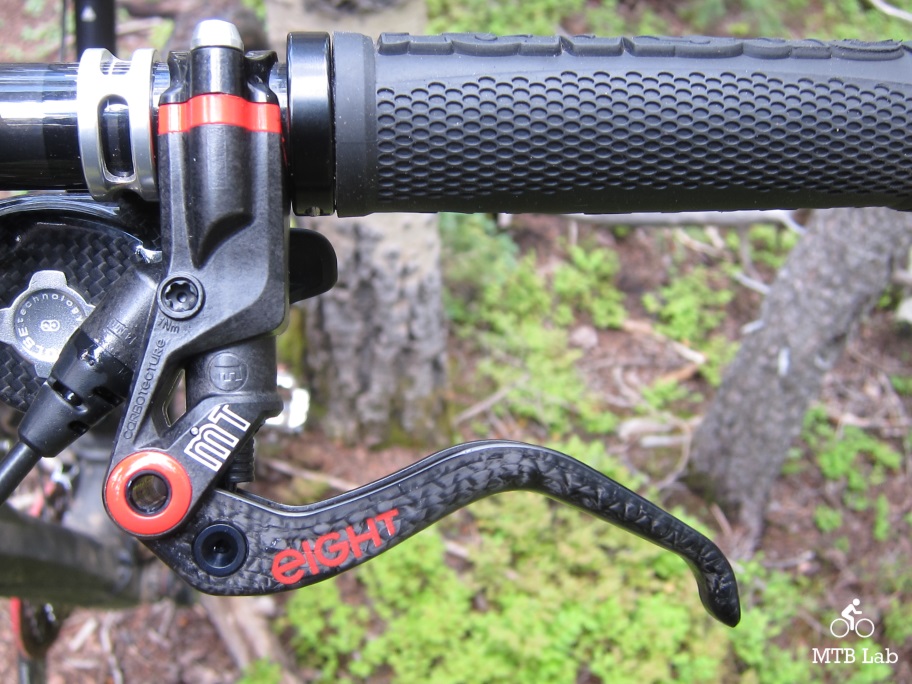
MT8
October 2011 – Magura’s stunning new MT8 brake is incredibly lightweight (278g w/ 160mm rotor), with excellent power and modulation and resistance to heat, drag, and squeal, all of which combine to make it stand out regarding performance. The high-tech works of art use amazingly innovative production techniques and materials to create a light and strong brake for any riding, from cross-country to downhill. It transcends being categorized within any riding style. It uses a Carbotecture SL carbon master body with the flip-flop design and dual EBT ports for bleeding, an alloy double arch caliper with top-loading pads, and Carbolay levers and split handlebar clamp.
Bottom Line
The Magura MT8 brakes are supremely functional, feature-laden, and highly engineered, and every single piece of the brake is pure bling. The lightness is a component of an entire slew of innovative technologies, from the carbon lever, reservoir, and clamp to the sculptured caliper and the special alloy bolts. The brakes have a superb tactile feel, which gives rise to an incredible touch, control, and communication, and your hands become ‘One’ with the ground/bike interface. The MT8s offer great modulation, excellent power, and heat resistance, and the rotors spin drag-free through the calipers. The caliper’s design makes them the quietest brake I have ridden, and even getting them extremely hot on long steep downhills never changed their silent characteristic.
Like anything with an expensive carbon lever that sticks out, I might be worried about breakage, but after multiple crashes (some slow and some fast), I haven’t had any issues, and the alloy clamp barrel does need to be tightened with caution. They aren’t the most powerful brake on the market, but they more than makeup for any deficit with other remarkable and useful traits.
In a nutshell, they are strong, light, quiet, fade-free, powerful, modulate well, and have a superb tactile feel from the ergonomic brake lever down into the ground. The brakes are the epitome of German perfection!
MT6
September 2012 – The Magura MT6 Next brake is lightweight (310g w/ 160mm rotor) and silent, with excellent power and modulation and resistance to heat, drag, and squeal, which all combine to make it stand out regarding performance. They use amazingly innovative production techniques and materials to create a light and strong brake for any riding, from cross-country to downhill. It transcends being categorized within any riding style. It uses a Carbotecture SL carbon master body with a flip-flop design and dual EBT ports for bleeding, an alloy double arch caliper with top-loading pads, alloy levers, and a split handlebar clamp.
Bottom Line
The Magura MT6 brakes are supremely functional, feature-laden, and highly engineered, and every single piece of the brake works in synergy. The lightness is a component of an entire slew of innovative technologies, from the carbon reservoir to the sculptured caliper and the special alloy bolts. The brakes have a superb tactile feel, which gives rise to an incredible touch, control, and communication, and your hands become ‘One’ with the ground/bike interface. The MT6s offer great modulation, excellent power, heat resistance, and the rotor’s spin drag-free through the calipers. The caliper’s design makes them one of the quietest brakes I have ridden, and even getting them extremely hot on long steep downhills never changed their silent characteristic.
They aren’t the most powerful brake on the market, but they more than makeup for any deficit with other remarkable and useful characteristics. They don’t offer the MT8’s lightweight (22g heavier), bling, and looks, but they make up for it with a better price point, and their alloy lever offers a noticeably firmer feel for a slight increase in control and power.
In a nutshell, they are strong, light, quiet, fade-free, powerful, modulate well, and have a superb tactile feel from the ergonomic brake lever down into the ground.
MT5
January 2015 – Magura revamped their MT brakes in 2014, and they increased power throughout the lineup and added two new four-piston systems, the MT5 and MT7. The four-piston MT5 brake is moderately light (380g w/ 180mm rotor) and silent, with excellent modulation and power and resistance to heat, drag, and squeal, and retails for $200 (w/o rotors), making for an outstanding performance-oriented package.
Bottom Line
In conclusion, the Magura MT5 four-piston brake has excellent power, superb modulation, and lever feel It offers precise braking and control, highlighting its feathering capabilities and lever feel.
The MT5 utilizes a Carbotecture master body and an aluminum lever, which has a tool adjustable reach and an aluminum caliper with four Duroplastic pistons with an embedded high-powered magnet to hold the pads in place. The brakes have a superb tactile feel, which gives rise to incredible touch, control, and communication, especially in technical terrain. The MT5s offer excellent modulation, power, heat resistance, and the rotor’s spin drag-free through the calipers. The caliper’s design and four-piston layouts make them the quietest brake I have ridden, and even getting them scorching hot on long steep downhills never changed their silent characteristic. They don’t offer the MT7’s lighter weight and increased leverage ratio, but they make up for it with a $200 price point, which is a practical budgetary constraint. I can’t vouch for the MT7’s increased power since I didn’t get to make a long-term comparison between the MT5 and MT7.
The dual-pad backing plate system MT5 can be challenging to remove due to the hanging hooks getting in the way during extraction. I would prefer they switch to the MT7 four individual pads, which have a top-loading system with a better tactile feel, less noise, and subtly better performance. After some time, the pads can build up some polish and glaze, and a quick light sanding of the pads removes them, returning them to top performance and decreased noise. The four-piston system offers increased performance, power, and fade resistance and improves the overall life of the pads, particularly with the slightly thicker material on the MT7 pads.
MT7
June 2016 – Magura’s flagship four-piston MT7 brake has incredible power, superb modulation and offers precise braking and control, with highlights to its feathering capabilities and lever feel. It uses their Carbotecture SL reservoir, an ergonomic aluminum lever with toolless reach adjustment, and a forged alloy 4-piston brake caliper with an adjustable banjo. The brake retails for $310 and weighs a moderately light 268 grams.
Bottom Line
The MT7 utilizes a Carbotecture SL master body, an aluminum lever with a toolless reach adjustable, and a forged alloy caliper with four Duroplastic pistons with an embedded high-powered magnet to hold the pads in place. The brakes have a superb tactile feel, which gives rise to incredible touch, control, and communication, especially in technical terrain. The MT7s offer excellent modulation, off-the-chart power, and heat resistance, and the rotor spins drag-free through the calipers. The caliper’s design and four-piston layouts made them the quietest brake I have ridden, and even getting them scorching hot on long steep downhills never changed their silent characteristic. After some time, the pads can build up some polish and glaze, and a quick light sanding of the pads removes them, returning them to top performance and decreased noise. They’re relatively light for a four-piston design and have so far been brutally tough and haven’t required any bleeding.
The MT7’s increased leverage ratio and four-piston design offered up the most powerful braking system I have used currently on the market. I mean, these suckers are potent killers and can stop on a dime anywhere.
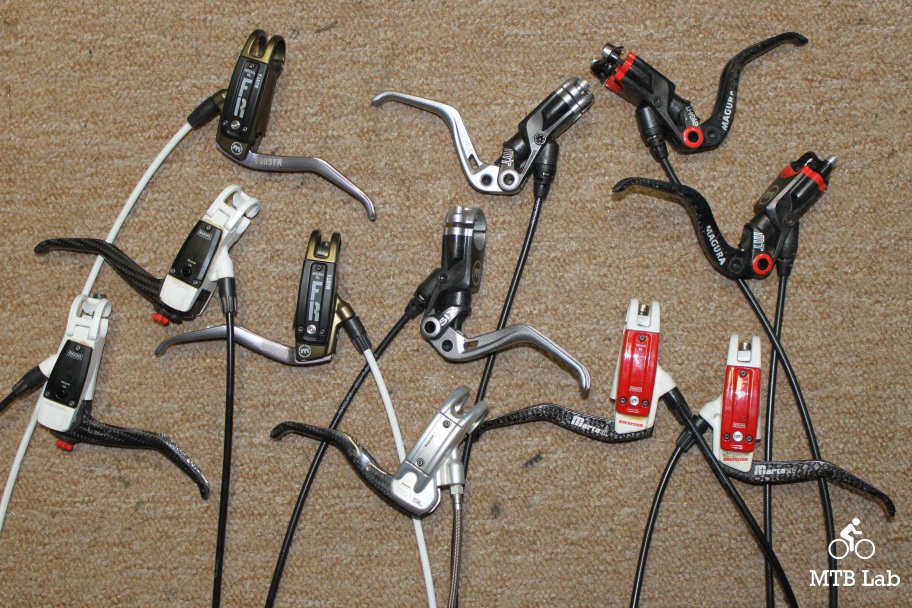
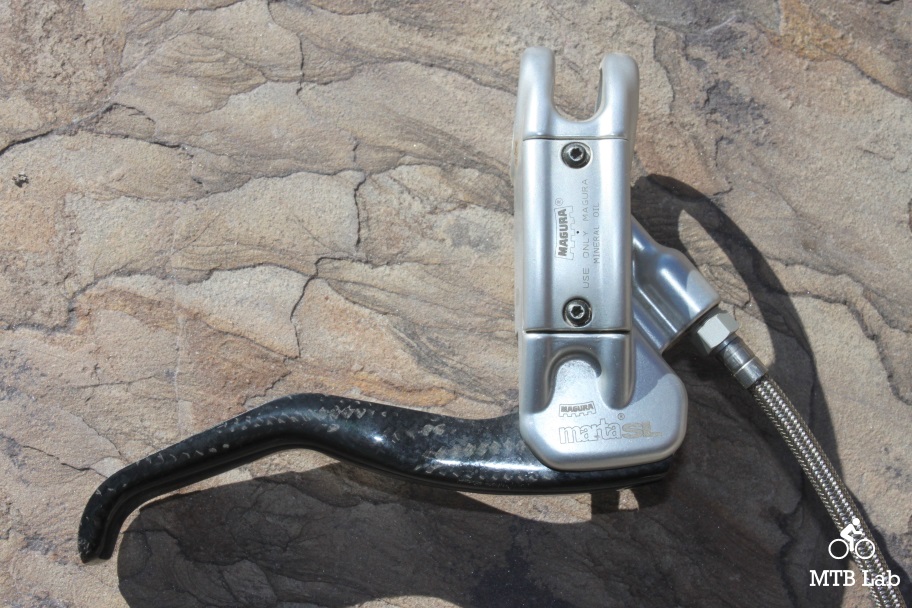
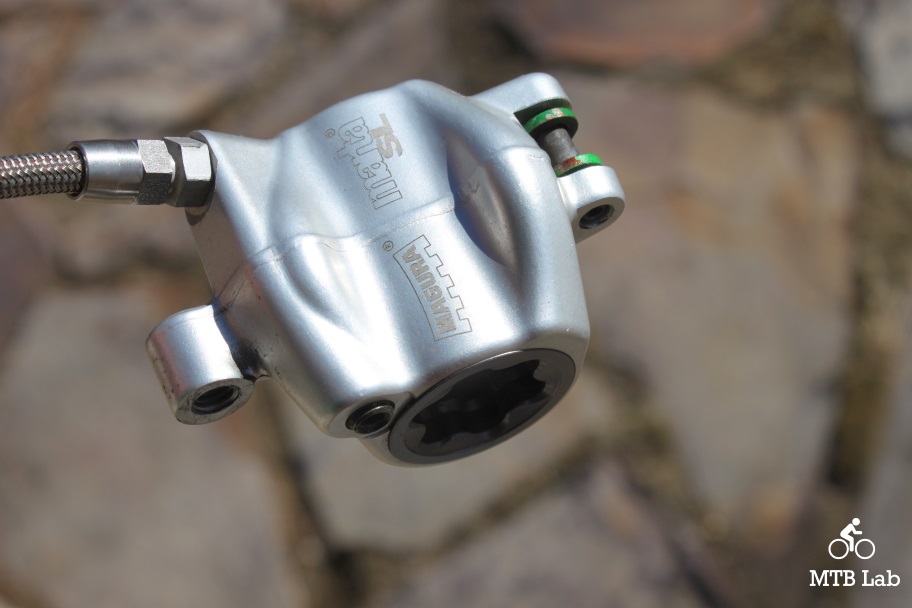
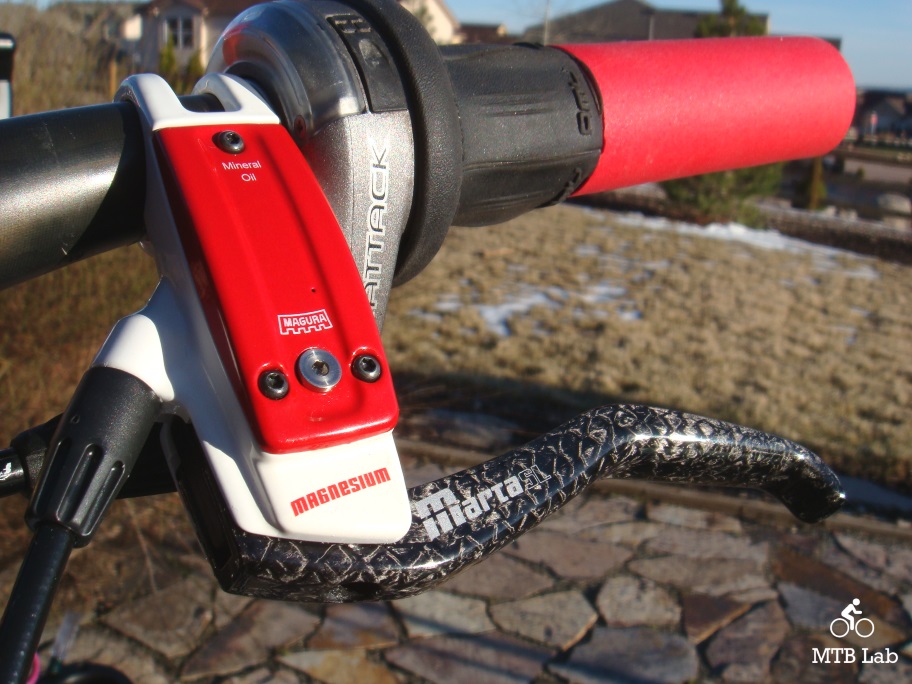
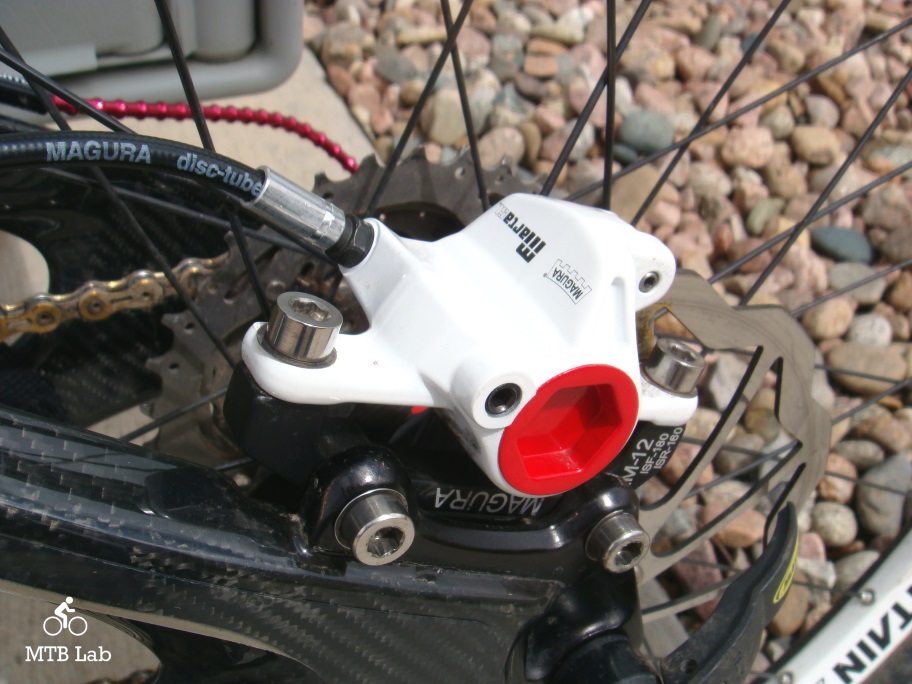
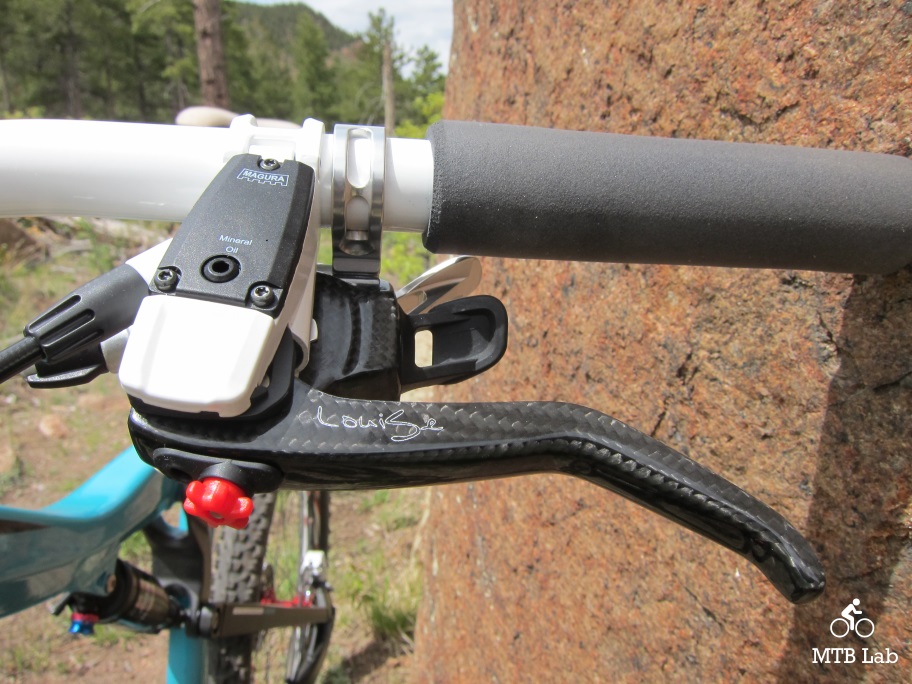
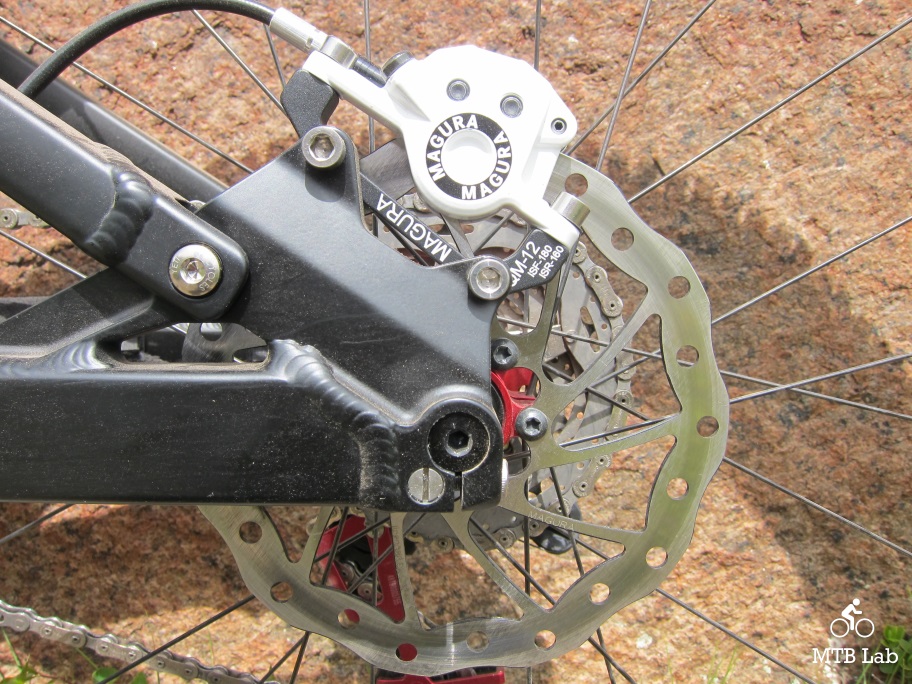
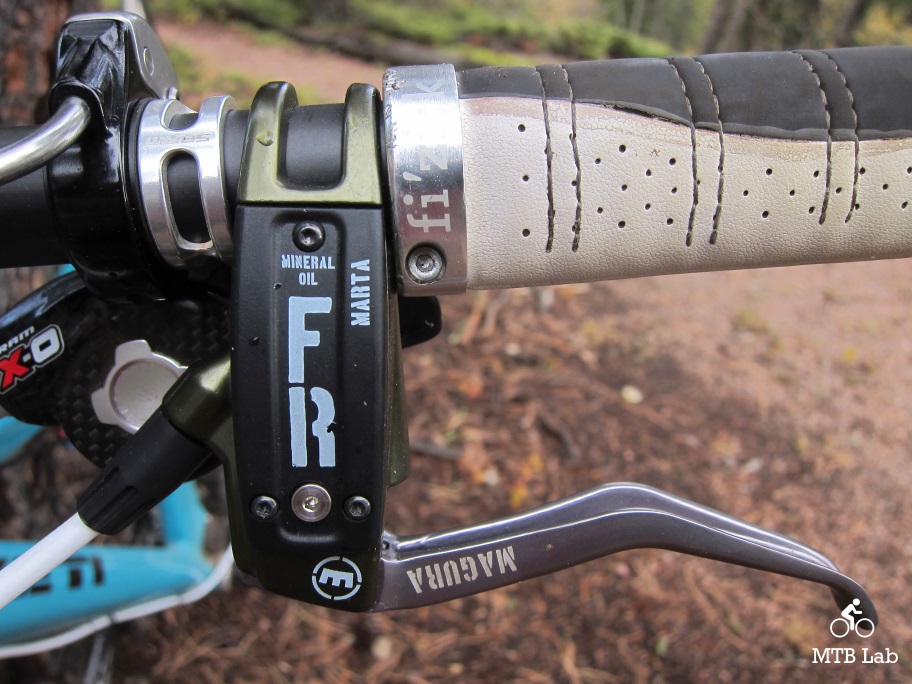
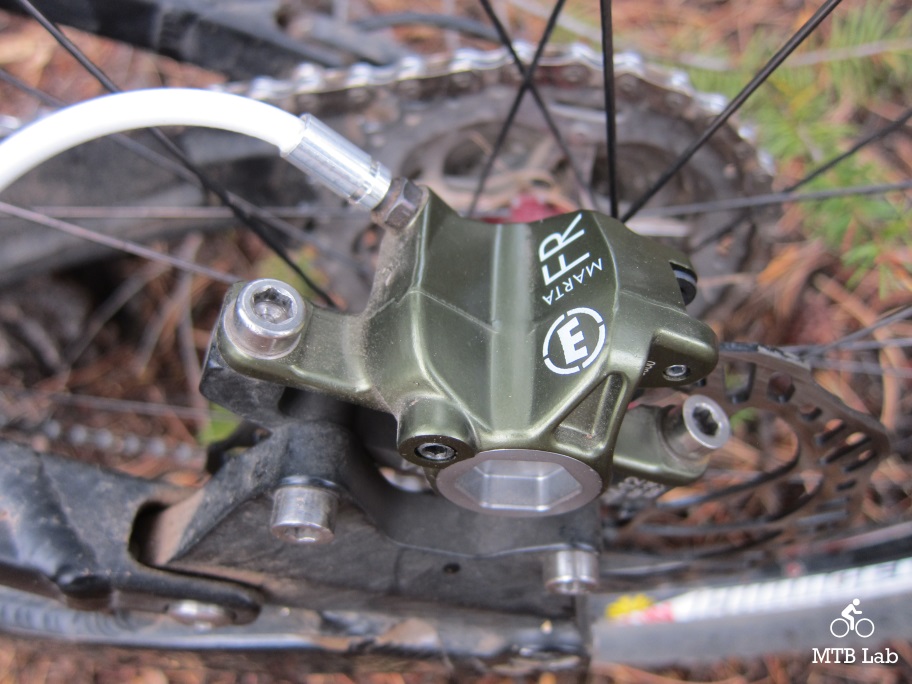
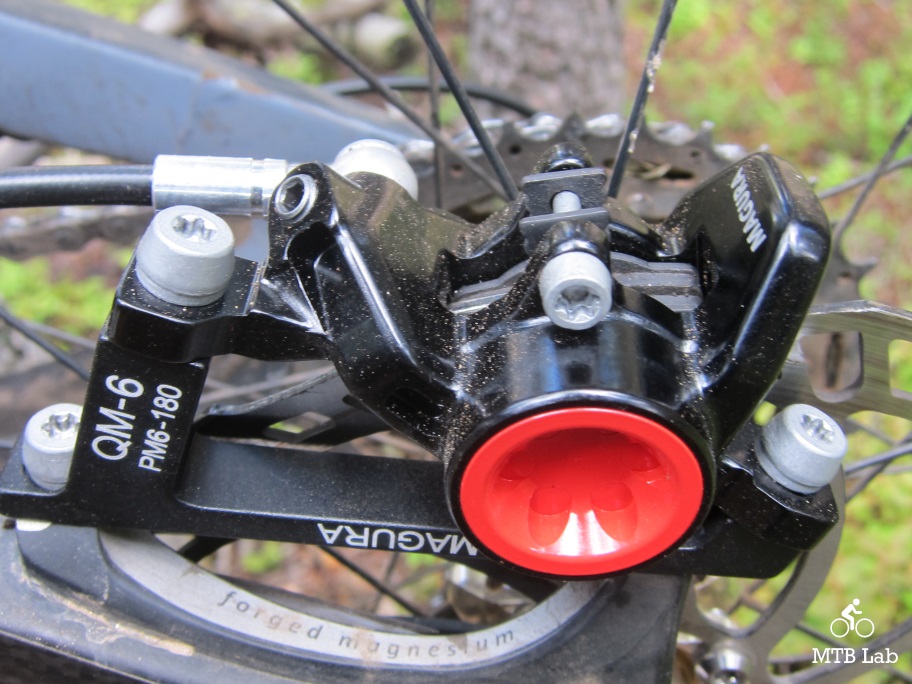
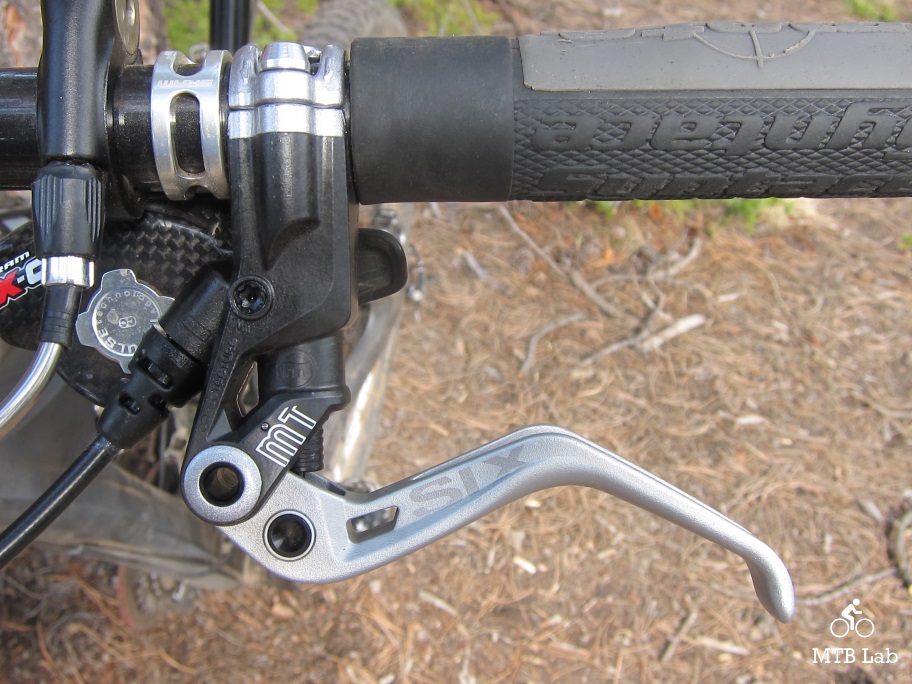
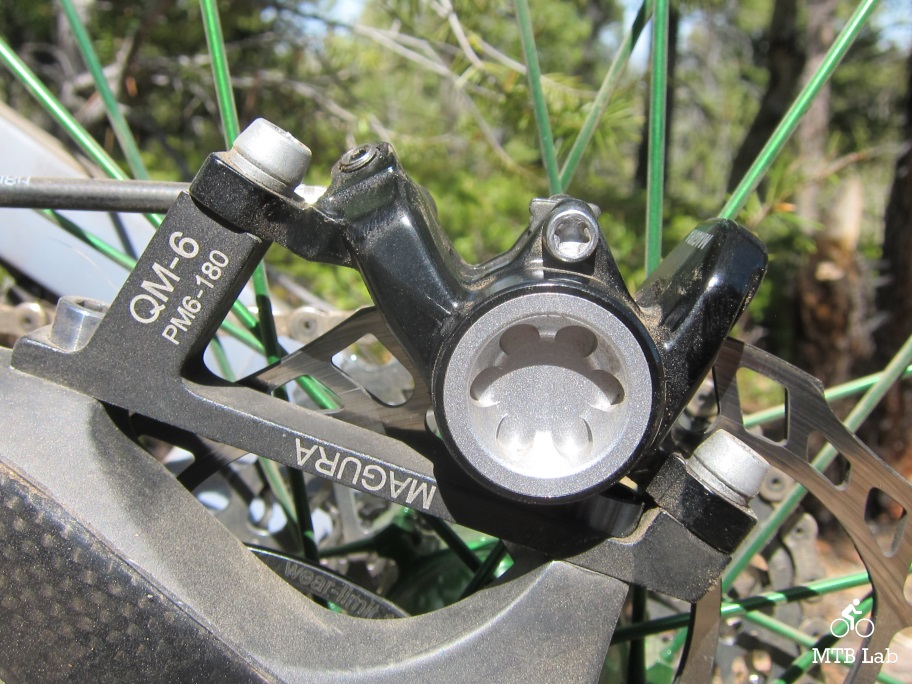
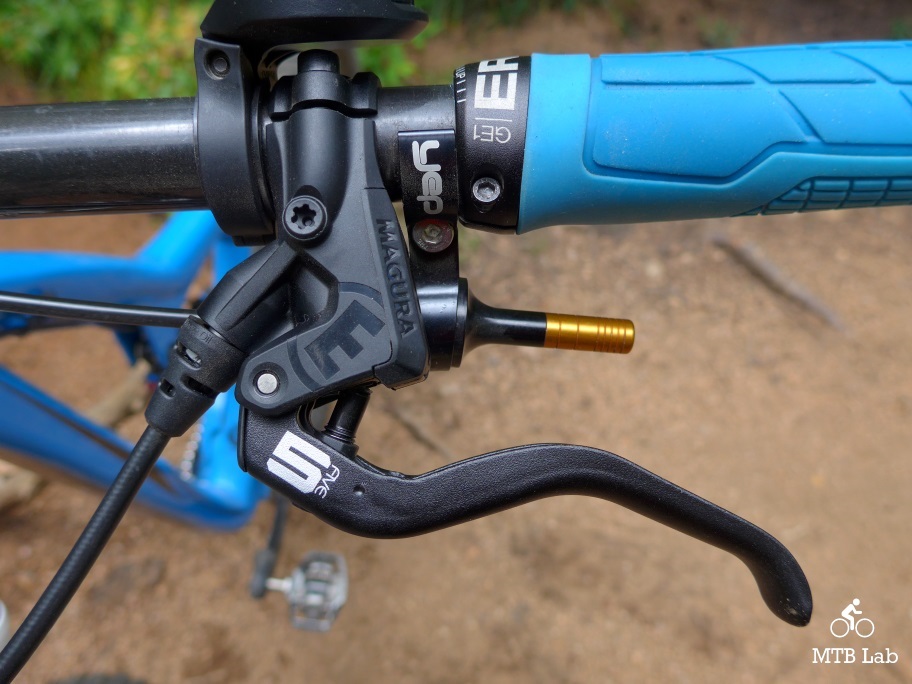
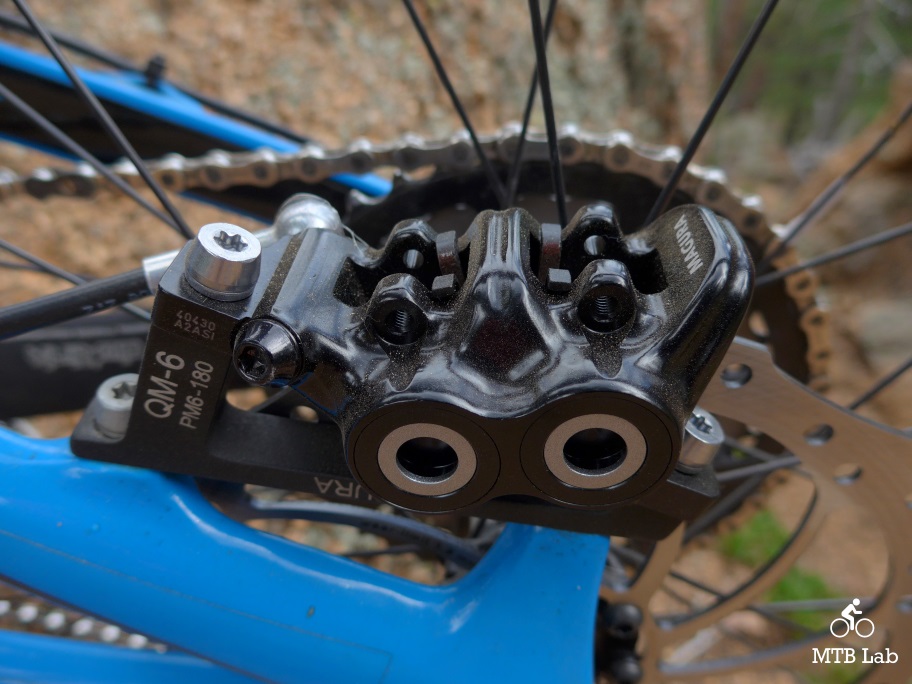

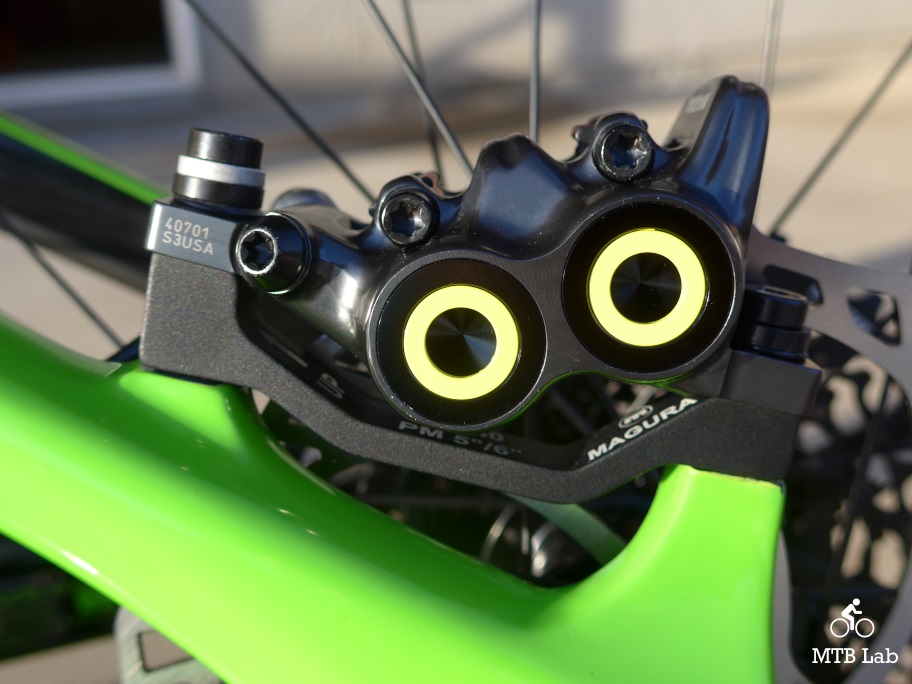





{ 6 comments… read them below or add one }
Hello I have a set of 2005 Magura Louise brakes
My rear brake has a sticky piston and despite cleaning it won’t fully retract after use resulting in rub on the rotor. Do you know whether the pistons can be removed. It is a sealed caliper similar to a Marta SL
Feel free to email me
Regards
Robert
New Zealand
Robert,
I conferred with the local Magura guru Jude, here was his response:
Yes the pistons can be removed and reinserted easily but why?
He should be able to force that stubborn piston back into its bore with a tire lever.
There is only a 4 side square seal holding the piston in place and position and easily to overcome its friction only hold.
The seal simply relaxes after lever blade is released thus pulling back its piston.
Nothing else.
If he can’t push the piston back, he may have too much fluid in the system.
Regards,
Brian
Hey,
I recently acquired an older Cannondale with Magura Marta SL’s. After bleeding they performed well, however I noticed the brake lever clamp is cracked (one part of the split collar, probably from fatigue or overtightening from the previous owner).
I would rather not replace one or both systems. What are my options? Have you got any experience in running a mixed set with a different 2 piston-lever? On the rather ghetto side of repairs, could it be point-welded or glued?
I’d think it would feel odd with different sets of brakes unless the brand matched. The same brand tends to have the same feel at the lever and caliper. I am not sure if a point-weld or glue job would do the trick, but you certainly could try it out. I’ve seen Marta SL’s on eBay on occasion if you wanted to replace one? Honestly, the new brakes from all brands have drastically improved.
The MTB Lab
Hi,
I,ve aquired an old Marta SL with a carbon lever. The hose was damaged and leaking so I decided to replace it with a
Goodridge braided hose. My problem is fitting the hose at the lever end…Do I use an olive and insert ? because the fitments that came with the Goodridge hose kit wont fit on the lever end….My original olive and insert are knackered – is there a product number for them so I can order the correct one?
I have reached out to one of my Magura brake guru’s to get a proper answer to your question. It’s been a long time since I worked on a braided line.
The MTB Lab